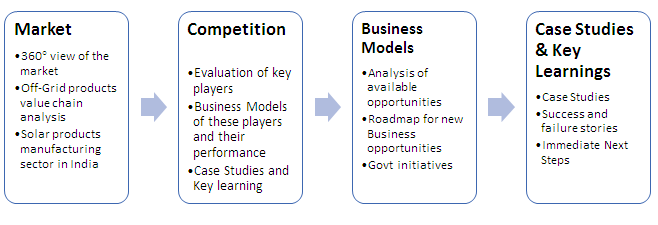Uncovering the Indian Off-Grid Solar Industry
Are you looking for innovative opportunities in Solar?
Take help from Solar Mango’s Intelligence report on the Off-Grid Solar Industry
While grid-connected solar projects enjoy the limelight, a large market exists for off-grid solar solutions due to the expense in extending or augmenting the conventional grid to areas where electricity is either absent or scarce. Off-grid solar presents a cost-competitive solution to such power hungry areas which currently depend on expensive solutions, such as diesel gensets or carting batteries, to obtain power.
If you are keen on exploring the fast growing off grid solar PV market, don’t miss reading this comprehensive guide.
Key applications for off-grid solar
- Diesel substitution
- Street and facility lighting
- Water pumping systems (irrigation, water treatment)
- Telecom tower energy
- Battery charging
- Mini-grids
What Will You Get to Know from the Report?
This report contains comprehensive inputs and in-depth insights on:
- Status and growth of the off grid solar PV industry ecosystem in India
- The key market segments within the off grid solar sector that is poised to grow in near future in India.
- Government policies, and regulations and incentives for the off grid solar market
- Exhaustive information about major Indian companies in different segments of the off grid solar value chain
- Information about foreign companies who have already initiated efforts to enter Indian off grid solar market
- Case studies of major off gird projects to help you learn from the experience of others
- Various options and strategies for entering the off grid solar PV market.
- Key pre-requirements for entering the Indian solar PV market.
- Successful business models that can be helpful for growing in the off gird solar sector
- Key challenges, bottlenecks and risks associated with this sector along with inputs on the mitigation strategies
- Growth drivers and success factors for the off grid solar sector
- Niche off grid applications where solar can play a vital role
- Ways to collaborate with NGO’s, financial integrators etc.
Key questions that the report will answer
- Is this the best time to enter the off grid solar PV market?
- What makes off grid solar PV market so attractive?
- What are the important National Solar Mission regulations you should be aware of?
- Do we need to have accreditation from standards bureau for our clients to qualify for MNRE subsidy?
- How should the subsidy be availed? Are there any bureaucratic bottlenecks in this process?
- Are the targets set by the government of India for the off grid solar industry realistic?
- In which states would it be most beneficial to set up solar projects-investment wise? How do various states fare in creating a suitable business environment to promote off grid solar energy sector?
- How is the willingness of financial institutions to fund off grid solar energy projects and solar products in rural India?
- What are the major attributes based on which off grid projects shall be financed?
- How will the fiscal incentives and subsidies offered by government impact the viability of solar energy based distributed power projects?
- What are the exciting business models and their success factors?
- What are the emerging business models in the off grid solar energy sector?
- In which part of the value chain should one enter?
- What are the new opportunities in manufacturing of equipment?
- What is the level of competitiveness in the market for off-grid solar PV systems and solar products?
- Who are the key players and what is the extent of their market penetration? Is there room for a new competitor?
- What are the key challenges for market penetration?
- Is there scope for growth without government subsidy?
- Is there any domestic content requirement for domestic solar products?
- Does the Indian govt. under JNNSM provide the proposed 30% capital subsidy to commercial/industrial entities in urban areas?
- In case the PV components are imported and they conform to international standards, would the components still need to be tested and certified in India?
- Are system integrators required to get any accreditation?
Why should you buy this report?
- The only comprehensive report available that gives all exhaustive information so that investor clearly understands the off grid market scenario
- Done after extensive primary research and thus contains the insights and perspectives from all the key stakeholders in the Indian solar PV market
- Clearly spells the various possible strategies to enter the growing off grid solar PV market.
- Written with actionable inputs – including details about successful business models, marketing channels, sales strategies etc
- Guides you step-by-step on how to enter the market
- Developed by EAI, considered the leading research and business intelligence firm for the Indian renewable energy industry.
List of Contents
- Off-grid Renewable Energy in India
1.1 Introduction to Off-grid Renewable Energy Sector
- Introduction to Solar Off-grid Applications and Products
2.1 Introduction
2.2 India‘s Unique Proposition
2.3 Solar PV Systems
2.3.1 Stand Alone PV Systems
2.3.2 Grid-tied PV Systems
2.3.3 Hybrid Systems
2.3.4 Residential Rooftops
2.3.5 Commercial Rooftops
2.3.6 Captive Industrial Solar Power
2.4 Solar Products- Thermal and PV
2.4.1 Solar Home Lighting
2.4.2 Solar Street Lights
2.4.3 Solar Lantern
2.4.4 Solar Water Pumps
2.4.5 Solar Cookers
2.4.6 Solar Water Heating System
2.4.7 Large Area Solar Dish Concentrator (ARUN-160) for Industrial Process Heat Systems
2.4.8 Emerging Solar PV Applications and Products
2.5 Market Status
2.5.1 Installed Capacity of Solar PV Systems and Power Plants
2.5.2 Future Outlook
- Solar Products Manufacturing
3.1 Overview of Off-grid Solar Manufacturing Sector in India
3.2 Drivers of Off-grid Solar Market Growth
3.3 Challenges and Bottlenecks for Off-grid Solar Industry
3.4 Key Aspects to Consider
3.5 Analysis of the Attractiveness of Off-grid Sector
3.5.1 SWOT Analysis
3.5.2 Risk Analysis
- Off-grid Products Business Value Chain Analysis
4.1 Solar Off-grid Products Value Chain
4.2 Business Opportunities inOff-grid Solar Products
4.2.1 Manufacturing Opportunities
4.2.2 Service Opportunities
4.2.3 Trading Opportunities
4.3 Off-grid Solar Sector – Alternative Business Models
4.3.1 Distributor-Dealer Channels
4.3.2 Proprietary Distribution Channels
4.3.3 Institutional Partnerships
4.3.4 Franchise Model
4.3.5 Rental /Leasing System
4.3.6 Electric Cooperatives
4.3.7 Pay As You Save (PAYS)
4.3.8 Choosing the Right Model for the Right Segment
4.4 Prominent Companies in the Various Stages of Off-grid Solar Products
4.4.1 Kotak Urja Pvt Ltd.
4.4.2 TATA BP Solar India Ltd
4.4.3 SELCO Solar Pvt. Ltd
4.4.4 KCP Solar
4.4.5 Central Electronics Limited (CEL)
4.4.6 D.Light Design Inc
4.4.7 HHV Solar Technologies Pvt. Ltd
4.4.8 Solkar Solar Industry Ltd
4.4.9 Aspiration Energy
- Government Initiatives/ Programs to Support Off-Grid Renewable Energy Deployment
5.1 Rajiv Gandhi Gramin Vidyutikaran Yojana (RGGVY)
5.2 Remote Village Electrification Programme
5.3 Subsidies / Incentives under National Solar Mission
5.4 Tax Incentives for Solar Products
5.5 Special Area Demonstration Project Programme
5.6 Renewable Energy Supply for Rural Areas (RESRA)
5.7 Renewable Energy for Urban, Industrial & Commercial Applications
5.7.1 Energy Efficient Solar/Green Building Programme
5.7.2 Solar City Programme
5.7.3 Akshaya Urja Shops
- Case Studies and Key Learnings
6.1 Rural Electrification- Experiences of SELCO Solar Light Pvt. Ltd.
6.2 Solar Water Pumps- Experiences of Aurore
6.3 Community Solar Power Plant- Experiences of Development Alternatives Group
6.4 Solar Powered Lanterns – Experiences of D.Light Design, Inc
6.5 Captive Solar PV Systems –Experiences of L&T
6.6 Captive Solar PV Systems – Experiences of SSN Research Centre
6.7 Solar Powered Weave Yarns – Experiences of PRADAN
6.8 Passive Solar Greenhouses – Experiences of GERES
6.9 Solar Lanterns– Experiences of Winrock International India (WII)
6.10 Solar Home Lighting– Experiences of Aryavart Gramin Bank
6.11 Solar Powered Computers– Experiences of Gnanmata Sadan School
6.12 Key Takeaways from the Case Studies
- Next Steps for Entering the Off-grid Solar Market
7.1 Steps to be Followed in order to Avail Government Subsidies/Incentives
7.2 Collaborating with Financial Integrators
7.3 Identification of Attractive Off-grid Segments
7.4 Opportunities in Various Off-grid Applications
7.4.1 Telecommunication Sector
7.4.2 Common Service Centers
7.4.3 ATMs
7.4.4 Water Pumping Systems
7.4.5 Large Commercial Buildings/Facilities
7.4.6 On-shore and Off-shore Oil & Gas
7.4.7 Desalination
7.4.8 Remote Monitoring Stations
7.4.9 Cathodic Protection
7.4.10 Others
7.5 Marketing of Clean Energy in Off-grid Markets
7.6 Understanding the Role of NGOs
7.7 Preparing Prefeasibility and Detailed Project Reports
7.7.1 Prefeasibility Report
7.7.2 Detailed Project Report for Solar Off-grid
- Frequently Asked Questions
Purchasing the Off-Grid Solar Guide
To purchase the Off-Grid Solar Guide, send a note to Ramya Gopinath – ramya@solarmango.com
 Skip to content
Skip to content

